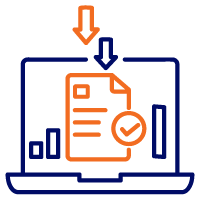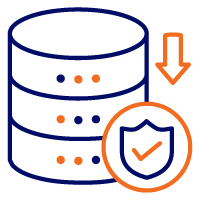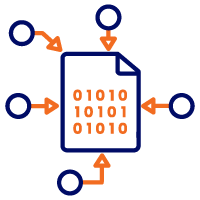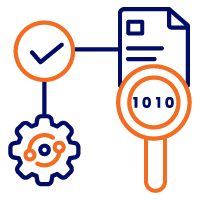What is data lineage?

Data lineage is the process of recording and tracking data through its lifecycle and is vital to data quality. To ensure that data used to support critical business decisions is trustworthy, one needs to know its origin. Data is constantly changing, updating, merging, and transforming. Data lineage documents all these processes, including who changed the data, where the data originated, and why the data was modified. As data flows through pipelines, metadata is created to feed data lineage tools that map connections and create visualizations of how data moves through its lifecycle. Mapping data connections provides insights into how upstream and downstream data are connected. Data lineage provides an audit trail for data.
Tracking Lineage Through Data Lifecycle
Lineage data is tracked through multiple stages of the data lifecycle, including collection, processing, access, storage, data querying, and data analysis. Understanding how and why lineage data is collected at each stage will support a more complete understanding of data lineage.

Collection
The first stage of data lineage starts with data collection. Once data enters a system, the source of the data needs to be documented. Systems must track where the data came from and the source's trustworthiness. It should note how valid and accurate the data is and any transformations or manipulations performed on a data set before entering a new system.

Processing
Once data has been collected, data lineage needs to track how it is aggregated, transformed, and manipulated. The probability of errors that create bad data is high when data is processed, merged, or filtered. These errors may not be identified until downstream users access and analyze the data, so proper documentation is essential for tracking any source of errors. Effective lineage requires metadata for each processing step to be created and stored.

Access and Storage
Once data is processed and stored, lineage data still needs to be captured. Data on who is accessing the data is required to support compliance audits. Data can be compromised when not stored correctly, so tracking how and where it is stored is also essential for end-to-end data lineage.

Data Querying and Analysis
Capturing data that details how data is queried and analyzed is also a significant capability when pursuing a complete data lineage strategy. Data lineage is not always about tracking data health, but also system performance. Data on how quickly and efficiently queries are performed can be analyzed to understand where there may be opportunities to optimize the entire pipeline. Administrators can also use this metadata to better understand how data is used and predict future usage patterns to anticipate users' needs.
Why Data Lineage is Important
Tracking data lineage is a key component in delivering trustworthy data. Understanding how data moves through different systems and processes and how datasets are connected helps administrators keep data and systems healthy. The ability to follow every stage of a dataset's evolution is also crucial in identifying the root causes of data errors.
By tracking changes in each phase of the lifecycle and mapping how each of these changes are related, troubleshooters can trace errors upstream to identify the root of the error. In many cases, errors in the data are not identified until the dataset has moved further downstream for analysis. Anomalies in data can signal a changing trend, or it could just be an error in the data. Knowing the difference is paramount to not missing an opportunity or avoiding making decisions based on wrong data. Tracing a data set from the analysis process back to when it was first collected provides much greater confidence in the health of data pipelines. Identifying root causes and implementing solutions will also help eliminate the possibility of the same errors repeating themselves.
Understanding how different datasets are connected also helps avoid errors in the first place. The ability to trace downstream dependencies enables developers and data engineers to predict the impact of changes on dependent applications and models. For example, a data engineer will understand the implications of changing table schema before making an adjustment. This knowledge can help them find a different path or edit downstream apps to reflect the upstream change and avoid errors or failures.
With a way to monitor your data processes across your entire data stack, you have a mechanism for validating the accuracy and integrity of your data. The ability to track data back to its source allows decision-makers to judge its validity. This knowledge is particularly important if the data originates outside the organization. Is the group that created a data set as focused on data quality as the users? This is valuable information if you make important business decisions based on this data.
Data Lineage helps in being compliant with regulations by tracking how and where data is stored and accessed. Adhering to data sovereignty and privacy rules, for example, as data lineage can tell if data has moved across country borders. Robust data lineage programs are also important to facilitate quick compliance audits. With data lineage, administrators can verify that data has been managed appropriately throughout the end-to-end data pipeline.
Different Approaches to Manage Data Lineage
While the value of end-to-end data lineage may be evident, access to all relevant metadata is not always possible. There are a few different approaches for analyzing data to create lineage. Pattern-based, Tag-Based, Self-contained, and Parsing.

Pattern Based
With pattern-based data lineage tracking, analysis of patterns in metadata reveals a dataset's history. This approach analyzes metadata across tables, columns, and reports to make connections. If two tables have similar names and data values, it can be assumed that they are different versions of the same table, and a link can be noted in a data lineage map. This approach is technology-agnostic because it focuses on data patterns and can work on any system. While pattern-based data lineage works well with a smaller number of data sets and may not be as effective with complex data relationships.

Tag-Based
A tag-based approach leverages a transformation engine to tag data, allowing it to be tracked as it moves through the pipeline. This approach is very efficient, but it only works if a uniform tool is used to process and tag data.

Self-contained
This approach uses master data management (MDM) tools to manage metadata centrally. Metadata created by various processes in the system is centralized in an MDM tool that can capture lineage data. The challenge is that processes performed outside the system that do not interact with the MDM tool cannot be tracked.

Lineage by Parsing
This process works by reverse engineering data transformations. By reading the logic used to transform data, the lineage of data can be surmised. This is a complex process, and all the languages and processes used to manage data across your data stack must be well understood. While complex, this process is best for tracking end-to-end data lineage across systems.
Best Practices for Managing Data Lineage
Focusing on the technology and metadata around your data lineage strategy is important, but your efforts will be wasted if decision-makers do not understand it. Lineage data should be comprehendible to both business and technical users.
Business lineage should also be considered as part of your strategy. Organize your data lineage with the right business context so business users can understand how data flows through business processes. Understanding what data is flowing through your pipelines is equally important as the technical lineage that tracks the how.
Data Lineage in Building and Using Data Products
Data lineage is vital in building and using data products. Data producers can audit data lineage to ensure the trustworthiness of data flowing into their data product. Lineage can also help data product producers understand dependencies and relationships between different data sets in their data products.
Business users of data products can also leverage data lineage to understand the flow of data and its source. This information helps them judge the validity of the data and its applicability to certain use cases. At the core of great data products is an extensive data catalog with built-in robust data lineage capabilities. Data catalogs help data product producers find and access the data they need, and data lineage data provides valuable information about that data.
Data lineage strategies are essential features of the modern data stack. As data pipelines become increasingly complex, a solid data lineage program will be essential to ensuring data quality.
Request a Demo TODAY!
Take the leap from data to AI
